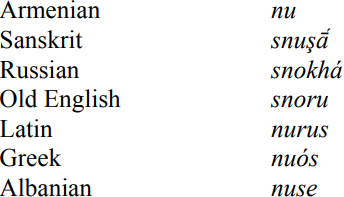
Reconstructing Proto-Indo-European words
 المؤلف:
P. John McWhorter
المؤلف:
P. John McWhorter
 المصدر:
The Story of Human Language
المصدر:
The Story of Human Language
 الجزء والصفحة:
42-9
الجزء والصفحة:
42-9
 2024-01-11
2024-01-11
 1143
1143
Reconstructing Proto-Indo-European words
A. Here is sister-in-law in seven Indo-European languages:

Actually, in Albanian and Armenian, the meaning of the root is now bride—semantic change is eternal.
To discover what the Proto-Indo-European word for sister-in-law was, we trace backwards. This method is called comparative reconstruction.
B. Some of the words begin with sn-, while others begin with n-. To decide whether the Proto-Indo-European word began with sn- or n-, we seek an account that squares with typical sound-change processes. Along those lines, it is more likely that several separate languages lost an s—by ordinary sound erosion—than that several separate languages somehow developed s for some reason (and always s). Thus, we know that the word began with sn-.
C. To decide whether the first vowel was an o or a u, we choose u, because more of the words have u than o. Again, it is more likely that a few words changed a u to an o than that many changed an o to a u. Thus, the first word would have begun with snu-.
D. The second consonant is a little harder to decide on. Three words—half of our set—have an s, but this is not a majority. Here, some additional information nudges us in the right direction. In many Latin words, r between vowels had begun as s. In Russian, many kh sounds trace back to s in earlier Slavic languages. This gives us a majority for s, and we can assume that the first word began with snus-.
E. The ending gives us a surprise.
1. Because sister-in-law is a feminine concept, if we are familiar with such languages as Spanish and Italian, in which -o is the masculine ending and -a the feminine one, we expect the original ending to have been -a. But Greek and Latin have -ós and -us, masculine endings, and in Armenian, when the word is given case endings, an o appears on the stem: nuo.
2. This is just three, not a majority. But then logic beckons: given that sisters-in-law are women, why would Sanskrit and Russian speakers have changed a feminine ending to a masculine one? In bizarre cases like this, we suppose that the ending must have originally been masculine and that some languages naturally “fixed” this over time and changed it to the more logical feminine ending. Thus, we have our original Proto-Indo-European word, the mysteriously cross-gender word snusos.
F. Through comparative reconstruction, then, we can know that a word that is merely nu in Albanian today began as the longer, chunkier snusos. Indo-Europeanists mark these hypothetical forms with an asterisk: *snusos.
 الاكثر قراءة في Linguistics fields
الاكثر قراءة في Linguistics fields
 اخر الاخبار
اخر الاخبار
اخبار العتبة العباسية المقدسة


